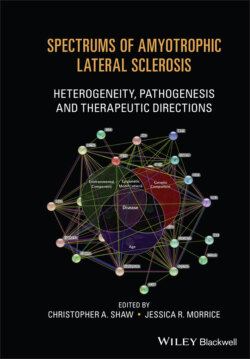Читать книгу Spectrums of Amyotrophic Lateral Sclerosis - Группа авторов - Страница 30
TAR DNA‐Binding Protein 43 (TDP‐43)
ОглавлениеInformed by prior observations of transactivation response (TAR) DNA binding protein 43 (TDP‐43) aggregates in neurons of ALS patients, the gene that encodes TDP‐43 (TARDBP) was screened for the presence of protein‐altering variants in simultaneous studies [15, 16]. Variants in TARDBP are a rare cause of ALS and are mainly clustered in the C‐terminal low‐complexity domain [17]. TARDBP variants account for 1–4% of familial ALS and are very rare in sporadic ALS [18], suggesting that altered TDP‐43 is a penetrant mechanism for ALS. TARDBP variants generally cause a dominant familial ALS [17] and are observed across ethnicities [7]. Certain founder populations can lead to a significantly increased incidence of TARDBP variants; for example, between 20 and 30% of Sardinian ALS patients carry the p.A382T variant [19, 20]. Despite the rarity of TARDBP variants, the implication of this gene has opened several avenues in ALS research.
TDP‐43 is an RNA binding protein, and it has specific transcript targets, which it binds and modifies [21, 22]. Normal TDP‐43 function involves repressing cryptic exons in mRNA, as variant (and silenced) TARDBP results in exons arising from intronic regions [23–25]. These cryptic exons are generally in nonconserved genomic regions [25]. Transcripts with cryptic exons tend to be processed through nonsense‐mediated decay, and lower expression of normal transcripts therefore results from altered TDP‐43 [24]. A loss‐of‐function model for TDP‐43 implicates not only mis‐spliced targets but also a lower expression of these targets. Conversely, conserved exons that should be included in properly‐spliced transcripts are skipped (skiptic) in cells with TDP‐43 variants [26]. In mice carrying certain variants in either the RNA‐binding or low‐complexity domains, exons were either aberrantly included (cryptic) or excluded (skiptic), respectively [26].
Cytoplasmic TDP‐43–containing inclusions are a common hallmark of ALS, appearing in as many as 97% of ALS cases [27] and in all but SOD1 variant carriers [28]. There is still debate about whether the aggregates are toxic per se. First, while most ALS‐causing variants occur in the C‐terminal region of the TARDBP transcript, aggregated C‐terminal TDP‐43 fragments do not appear to be the driving force of the pathology [29]. Second, the N‐terminus of TDP‐43 appears to strongly affect cell pathology and aggregation [30], although ALS‐associated variants are not often observed in the first exons of TARDBP. Lastly, the normal function of the RNA‐binding domains of TDP‐43 appears to prevent the aggregation of the protein: when RNA targets of TDP‐43 are not available to bind, aggregation of TDP‐43 increases [31]. Supporting the involvement of RNA‐binding for ALS pathology, TARDBP variants require intact TDP‐43 RNA‐binding domains to exert neurotoxic effects [32].
